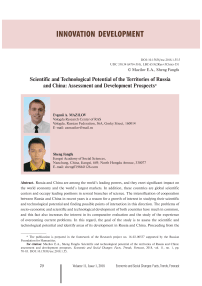Scientific and technological potential of the territories of Russia and china: assessment and development prospects
Автор: Mazilov Evgenii A., Sheng Fangfu
Журнал: Economic and Social Changes: Facts, Trends, Forecast @volnc-esc-en
Рубрика: Innovation development
Статья в выпуске: 1 (55) т.11, 2018 года.
Бесплатный доступ
Russia and China are among the world’s leading powers, and they exert significant impact on the world economy and the world’s largest markets. In addition, these countries are global scientific centers and occupy leading positions in several branches of science. The intensification of cooperation between Russia and China in recent years is a reason for a growth of interest in studying their scientific and technological potential and finding possible points of interaction in this direction. The problems of socio-economic and scientific and technological development of both countries have much in common, and this fact also increases the interest in its comparative evaluation and the study of the experience of overcoming current problems. In this regard, the goal of the study is to assess the scientific and technological potential and identify areas of its development in Russia and China. Proceeding from the goal, the article studies theoretical aspects of scientific and technological development of territories and provides our own interpretation of the concept “scientific and technological potential” based on the combined option that unites the resource-based and effective approaches to this economic category...
Scientific and technological potential, assessment technique, problems, differentiation, territories, development directions
Короткий адрес: https://sciup.org/147224028
IDR: 147224028 | DOI: 10.15838/esc.2018.1.55.5
Список литературы Scientific and technological potential of the territories of Russia and china: assessment and development prospects
- Alfer’ev D.A. Forecast of innovative activity development in Russia. Problemy razvitiya territorii=Problems of territory’s development, 2015, no.6 (80), pp. 201-213..
- Gerasimov A.V. Innovation potential as a framework for economic development of Russian regions. Biznes v zakone: ekonomiko-yuridicheskii zhurnal= Business in law, 2011, no. 6, pp. 296-299..
- Mindeli L.E., Khromov G.S. Nauchno-tekhnicheskii potentsial Rossii . Part 2. Moscow: TsISN, 2003. 122 p.
- Mazilov E.A. Razvitie promyshlennogo kompleksa v kontekste modernizatsii ekonomiki regiona . Scientific supervision by Gulina K.A. Vologda: ISERT RAN, 2015. 164 p.
- Gulin K.A., Mazilov E.A., Kuz’min I.V., Alfer’ev D.A., Ermolov A.P. Scientific and technological potential of a territory and its comparative appraisal. Problemy razvitiya territorii=Problems of territory’s development, 2017, no. 1, pp. 7-26..
- Emeshkina M.S. The cooperation of Russia and China in the field of scientific and technical collaboration in their historiography of the problem. Oikumena. Regionovedcheskie issledovaniya=Ojkumena. Regional researches, 2009, no.1 (8). Available at: http://cyberleninka.ru/article/n/vzaimodeystvie-rossii-i-kitaya-v-oblasti-nauchno-tehnicheskogo-sotrudnichestva-k-voprosu-ob-istoriografii-issledovaniya (Accessed: 18.10.2017)..
- Alfer’ev D.A. Innovatsionnaya aktivnost’ organizatsii -osnova nauchno-tekhnologicheskogo razvitiya ekonomiki . Ekonomika i upravlenie v XXI veke: nauka i praktika: materialy IV mezhdunar. nauch.-prakt. konf. . Cherepovets, May 27-28, 2016. Cherepovets: Filial SPbGEU v g. Cherepovtse, 2016. Pp. 62-66.
- World Bank official website. Available at: https://data.worldbank.org/indicator/IP.JRN.ARTC.SC?end=2013&locations=CN&name_desc=true&start=1981&view=chart..
- Federal State Statistics Service official website. Available at: www.gks.ru.
- Regiony Rossii. Sotsial’no-ekonomicheskie pokazateli. 2015: stat. sb. . Rosstat. Moscow, 2016. 900 p.
- Official website of Eurostat. Eurostat. 2016. Available at: http://epp.eurostat.ec.europa.eu/portal/page/portal/science_technology_innovation/data/main_tables.
- Science and Technology. Community Innovation Survey. Eurostat. 2012. Available at: http://epp.eurostat.ec.europa.eu/portal/page/portal/statistics/search_database.
- The measurement of scientific and technological activities. Oslo manual. Guidelines for collecting and interpreting innovation data. Organization for Economic Co-operation and Development; Statistical Office of the European Communities. Paris: OECD, 2005. 163 p.
- Jarunee Wonglimpiyarat Innovation index and the innovative capacity of nations. Futures, 2010, no. 42 (3), pp. 247-253.
- Kurakova N.G., Zinov V.G., Tsvetkova L.A. Natsional’naya nauchno-tekhnologicheskaya politika «bystrogo reagirovaniya»: rekomendatsii dlya Rossii: analitich. doklad . Moscow: Delo, 2016. 160 p.
- Xionghui C. et al. The research of regional innovation capability measure in Guangdong province which Based on the theory of complex network. Scientific and technological progress and countermeasures, 2010, no. (20), pp. 121-124.
- Jiancheng G., Shuzhong L. Comparing regional innovative capacities of PR China-based on data analysis of the national patents. Technology Management, 2005, no. 32, pp. 225-245.
- Liu X., White S. An exploration into regional variation in innovative activity in China, International journal of technology management, 2001, vol. 21, no. 1/2, pp.114-129.
- Liu X., White S. Comparing innovation systems: a framework and application to China’s transitional context. Research Policy, 2001, no. 30, pp. 1091-1114.
- Xibao L. China’s regional innovation capacity in transition: an empirical approach. Research Policy, 2009, no. 38 (2), pp. 338-357.
- Xie X., Liu F. Analysis on regional technology innovation efficiency evaluation and influence factors in China. International journal of business and management, 2015, no. 10 (3). Available at: http://dx.doi.o. v10n3p169 DOI: rg/10.5539/ijbm


